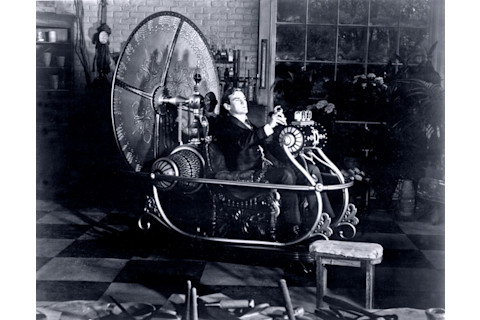The future’s not what it used to be.
By all accounts, it should be here by now. The new millennium is old enough to vote. NASA has been in space for half a century. Virtually every house has a computer, and every pocket a smaller, cuter one.
And yet the promised future is incomplete. Where, as the refrain goes, is my flying car? Our jetpacks? Why does it even still rain on us? Is it not the future?
Well, yes and no. Some of our promised future gizmos have already arrived — even if they’re prohibitively expensive — and some are literally impossible. As novelist and future fabulist William Gibson has said, “The future is already here — it’s just not very evenly distributed.”
Ultimately, the future is whatever you make it, Doc tells us in Back to the Future Part III. So here’s what we’ve made of some of the most popular promised technologies.

Comic book illustrator Alex Schomburg’s 1953 cover art for Science Fiction Plus. (Credit: Courtesy of The Estate of Alex Schomburg)
Courtesy of The Estate of Alex Schomburg
Jetpacks
What is it? A machine worn as a backpack that lets you fly, usually via jet engine.
Where you’ve seen it: The Rocketeer, The Jetsons, Iron Man (though not a back-based variation)
Why it’d be so cool: One of our most primal urges is to soar around as easily as birds. The jetpack lets us do it in the most “natural” way: no cockpits shielding us from the wind, no hot air balloons leaving us at the mercy of air currents, just pure high-flying action. You could take the fastest route to work every day, literally as the crow flies. Or shoot over to the neighboring country to see the sites. And let’s not forget about the military advantages if a jetpack came standard with every soldier’s uniform. Ultimately, the jetpack is about freedom. Fly in or out of any situation you want, and look badass while doing it.
When were we supposed to have it: Although usually shorthand for “the future,” The Rocketeer’s jetpack came about in the 1930s, so we’re way behind on that score.
How close are we? You could fly around in a jetpack right now … if you’re in the right environment.
In space, astronauts have been scooting around in so-called manned maneuvering units since 1984. Not an astronaut? You’ll have better luck over water. Hydro jetpacks, including the name brand Flyboard, use Jet Ski-like technology to shoot water instead of a gas propellant. The catch: It needs a fuel source. So while these machines look and apparently feel an awful lot like traditional flying jetpacks, they’re still literally tethered to the water.
So what about the real deal? It’s possible, but not exactly as consumer tech. JetPack Aviation, whose CEO flew around the Statue of Liberty in 2015, offers promotional flights and training; no FAA pilot’s license required. Or how about the Flyboard Air, a jetpack for your feet? The catch: It lasts only 10 minutes, costs $250,000 and isn’t actually for sale yet.
Ultimately, there’s a reason consumer jetpacks are not more available in real life. The jet itself would be extremely dangerous to other fliers and careless pilots — to say nothing of the flames shooting out — and it would probably be uncomfortably loud and cumbersome. And, basically, humans just aren’t very aerodynamic, so controlling such a device at any speed is tricky.
Still, at least there are options.
Fun Fact: The Rocketeer wasn’t all lies. The Nazis really did try to get their hands on jetpack technology over 80 years ago. Luckily, creating a flying backpack wasn’t any easier back then.

This Convair Model 118 actually flew in 1947. The company hoped to make flying cars mainstream after World War II. (Credit: Aviation-images.com/Mary Evans Picture Library)
Aviation-images.com/Mary Evans Picture Library
Flying Cars
What is it? It’s a car … that can fly. (Usually a sportier model.)
Where you’ve seen it: Back to the Future, Blade Runner, Futurama, The Fifth Element
Why it’d be so cool: Controlled flying is a relatively recent development for our species — the first airplane flew only about 115 years ago. It still feels cool and futuristic to picture ourselves, as a species, casually puttering around in the air. Just as a prosperous family could enjoy a personal boat trip or car ride, the personal flying car symbolizes one more realm we’ve mastered, another technological hurdle we’ve cleared. Plus, the views are nicer, the traffic less congested, and it looks like so much fun.
When were we supposed to have it: The Back to the Future trilogy optimistically suggested they’d be ubiquitous by 2015, and Blade Runner in 2019. Either way, the not-too-distant future.
How close are we? Surprisingly close! Flying cars already exist as prototypes. Right now for a cool $10,000 deposit, you can reserve an honest-to-God flying car from Terrafugia, called the Transition. The problem is they’re more like drivable planes. You’d still need a special area for takeoffs and landings, and, oh yeah, you need to know how to fly a plane. And another thing, the Transition isn’t currently in production; it’s still a few years away. (In other words, the not-too-distant future.)
Ultimately, planes are plane-shaped for a reason, and it’s much more practical to use one to fly, and a car to drive. After all, we don’t try to combine power saws and flamethrowers into one ultracool multitool.
Still, the basic technology is there, and combined with autonomous driving possibilities — Uber is promising flying drone cars by 2020 — it just might be possible that we’ll have our flying cars after all.
Fun fact: The idea of flying cars goes back further than you may think. The first patent for one was issued in 1918.

In a 1960 film adaptation of H.G. Wells’ The Time Machine, actor Rod Taylor plays a Victorian-era inventor who journeys into the fourth dimension on a sled attached to a large clock. (Credit: Everett Collection)
Everett Collection
Time Machine
What is it? A contraption that lets you explore different time periods.
Where you’ve seen it: The Time Machine, Back to the Future, Bill & Ted’s Excellent Adventure, Doctor Who
Why it’d be so cool: We’re a species that likes to roam, to explore the wild blue yonder. What greater unexplored realms are there than the past and the future? Historians could answer all their unsolved questions, and scientists could get a leg up on upcoming technology. You could spend time with departed loved ones, and see what awaits your family — and species — in the years to come. The possibilities are as endless as time!
When were we supposed to have it: The Time Machinecame out in 1895, so at least since then. They’re usually depicted as contemporary technology taking place whenever the story happens, so really, they should be here already.
How close are we? Not at all.
Technically, simply by existing we are traveling forward in time at 1 second per second, so in that sense everything is a time machine. Physics has also taught us ways to toy with that flow of time a little bit. You age slower the closer you are to a large mass like Earth, for example.
But as for a machine that transports you wherever you want in time and, presumably, space? Nope. It’s pretty much impossible, as far as we know. Sorry.
Fun fact: Because of relativity, astronauts who spend six months in space have aged some 0.007 seconds less than everyone who stayed on the ground. Baby steps?

The Enterprise jumps to warp speed in 1979’s Star Trek: The Motion Picture. (Credit: Paramount/Everett Collection)
Paramount/Everett Collection
Warp Speed
What is it? The ability to travel faster than the speed of light — often at multiples of it.
Where you’ve seen it: Star Trek, Star Wars, The Last Starfighter — pretty much anything with “star” in the name
Why it’d be so cool: “Space,” Douglas Adams informs us, “is big. Really big.” In order to get anywhere, either you need to plan for years’ worth of travel, or you need to travel faster than the speed of light — the current speed limit for matter, if Albert Einstein is to be believed. But if we could somehow achieve superluminal speeds, we’d be free to travel almost anywhere, “boldly going” wherever we like, the solar wind in our hair. The galaxy, and possibly the universe itself, opens up to us.
When were we supposed to have it: The only firm date seems to be when Star Trek’s Zephram Cochrane invents a warp drive in 2063; otherwise, it’s just a background staple of sufficiently advanced societies.
How close are we? Not very.
Einstein’s theories have been verified enough to suggest if we ever can break the cosmic speed limit, it’s going to take more than just going really fast.
Mexican theoretical physicist Miguel Alcubierre came up with a way to sort of do it: Simply warp space-time around a spaceship to create a moving bubble within the fabric of the universe. Make the bubble just right, by shrinking the space in front of it and expanding the space behind, and it could zip around the universe much faster than light. The ship and its immediate surroundings wouldn’t be traveling faster than light — they wouldn’t even feel the effects of the movement — it’d be the universe itself moving the bubble around. And that’s OK by Einstein. It’s an elegant solution, but unfortunately it requires currently impossible technology to work (such as creating something with negative mass).
Einstein also doesn’t forbid warp drives that tap into a hidden dimension — like Han Solo jumping to “hyperspace” — allowing spaceships to take faster-than-light shortcuts throughout the cosmos. But again, there’s no evidence any of that is actually possible; we just can’t say for sure that it isn’t.
Fun fact: Pluto is over 5 light-hours away, and it would take more than four years traveling at light speed to reach the nearest star. That’s a lot of sitting around.

A hologram ad appeals to K (Ryan Gosling) in Blade Runner 2049. (Credit: Warner Bros./Everett Collection)
Warner Bros./Everett Collection
Virtual Self/Avatar
What is it? A way to appear exactly as you’d like to be seen; often limited to digital spaces.
Where you’ve seen it: The Matrix, Ready Player One, Snow Crash, Blade Runner 2049
Why it’d be so cool: You could easily become everything you’ve ever wanted to be. What’s not to love? Shave a few pounds, or show off the curls you’ve always dreamed about. Or go further and let people see you as the mythical beast you see yourself as. The race and sex you were born with need no longer affect you. Suffer from a physical disability, or confined to bed rest due to an illness? Now it wouldn’t even matter. Traveling the world, or digital worlds, from the safety of your computer, looking exactly how you envision yourself, is the ultimate way to live life on your own terms.
When were we supposed to have it: Usually this is a near-future technology; most of the examples above take place over the next few decades.
How close are we? We’re there! Sort of.
Video games and internet forums have used a form of this for years, allowing players and users to customize their appearance, often called their avatar (as in Snow Crash). As the technology has improved, so has the virtual you, appearing ever more intricate and complex — possibly even photorealistic at this point. Whether it’s an actual photo or illustration appearing next to your words, or a fully designed three-dimensional body moving around the space, this is how the digital world sees you.
The only problem is that the rest of the actual world doesn’t see you as your bitmoji. To get to that point, the majority of our interactions must be digital. And right now, the real world is still just too convenient a meeting space.
But it’s possible we’re heading in that direction. Second Life — a “virtual world” that exists as a fully functional alternative place to create, entertain and do business with others — peaked at over a million monthly visitors and $3.2 billion in total transactions after its first 10 years. Other online universes like the communal video game World of Warcraft boast even higher user numbers. So the dream is already real for an awful lot of people, and if our growing time online is any indication, a digital lifestyle may be in all our futures.
Fun fact: As virtual reality becomes more widespread, programs like VR Chat and Sansar make interacting with other users’ avatars easier and more realistic.

The International Space Station keeps quietly ticking along. (Credit: NASA)
NASA
We've Come a Long Way
Sometimes the transition from science fiction gadget to everyday tool goes smoothly. Here are some now-mundane technologies our ancestors once only dreamed of.
Personal computers: From the storytelling engine in Gulliver’s Travels to Isaac Asimov’s Multivac supercomputer, computational devices are common throughout literature. And thanks to technological advances of the past decades, they’re now as ubiquitous as McDonald’s, with over a billion PCs currently in use.
Television: What could be more futuristic than the idea of capturing a moment’s sights and sounds, seeing and hearing a story or news report a world away? And yet, since the first models appeared almost a century ago, we’ve become bored with the devices. High-fidelity sound, perfect — even 3-D — pictures and still, nothing worth watching.
Cellphones: Star Trek may have had some questionable technology, but the communicators of the original series are nothing but classic Motorola RAZRs. We’ve actually improved: More than three-quarters of Americans own smartphones (enabling the sci-fi dream of video calls in the process), most of which are hundreds of thousands times more powerful than NASA’s early spaceships. To boldly go indeed.
Space travel: Once we figured out flying, it took only a few decades to get to the moon. A successful mission to the International Space Station doesn’t even warrant news coverage these days.
Robot vacuums: It’s not all society-altering stuff. Sometimes the cool little things work out, too. Take the idea of robot vacuums, as seen in The Jetsons and other comic sci-fi settings, made into reality by Roomba (among others) over 15 years ago. We really are living in the future.
Editor's Note: This article has been corrected to state that you age more slowly when in the presence of a large mass, not more quickly. This article originally appeared in print as "Whatever Happened to the Future?"















